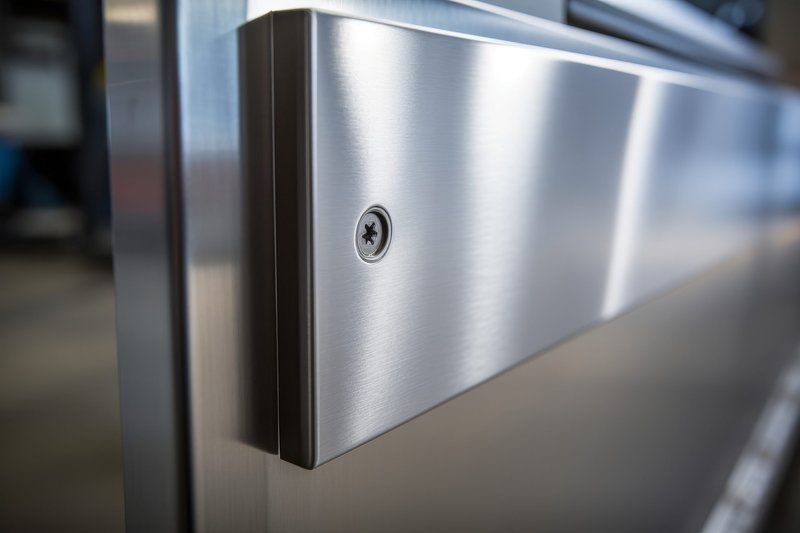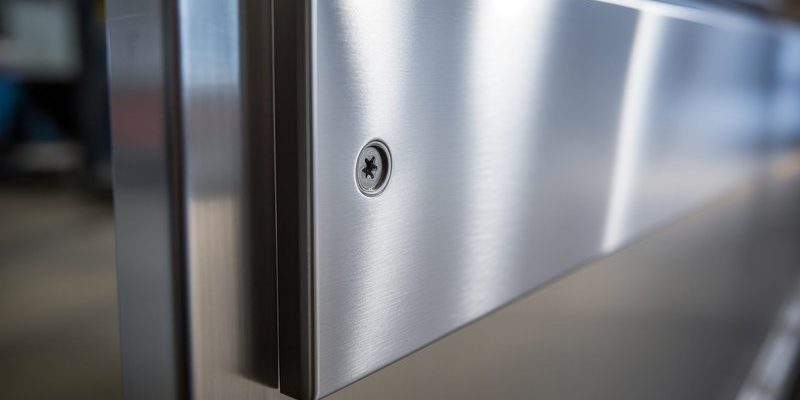
If you’ve just installed a Schlage matte black kick plate, for example, you might glance down after a few weeks and wonder, “How am I supposed to keep that looking fresh—without leaving streaks or ruining the finish?” Honestly, keeping matte black hardware clean isn’t rocket science, but it does take a bit of know-how. Let’s walk through what works, what doesn’t, and how to make that matte black look as good as the day you bought it.
Why Matte Black Kick Plates Need Special Care
It’s tempting to think matte black finishes are trouble-free. After all, they’re designed to hide fingerprints and look cleaner longer—right? Well, kind of. Matte finishes don’t reflect light, so smudges and fine scratches can sometimes show up more than on glossy surfaces. Over time, even tiny bits of dirt or the wrong cleaning habits can leave the kick plate looking chalky or streaky.
Most matte black kick plates—like those from Baldwin, Schlage, or Emtek—aren’t actually painted black all the way through. Instead, they’ve got a special powder-coated or anodized layer that sits on top. This finish is tough but not indestructible. The wrong scrubber, harsh chemicals, or even too much elbow grease can break down that layer, leaving you with dull patches or shiny spots.
You might be tempted to reach for a “universal cleaner” or household degreaser, but those are usually too harsh for matte finishes (and can even void the warranty). Think of your matte black kick plate a bit like a non-stick frying pan: sturdy, but happiest with gentle care. If you treat it right, it’ll protect your door and look awesome for years.
Step-by-Step: How To Clean a Matte Black Kick Plate
Here’s the thing—cleaning a matte black kick plate doesn’t require fancy tools or rare cleaning supplies. Mostly, you just need to be careful, gentle, and patient. Here’s how I tackle mine:
- Dust first: Use a dry microfiber cloth to gently wipe away loose dust and dirt. This prevents you from dragging grit across the finish later.
- Use a mild cleaner: Mix a couple drops of gentle dish soap (like Dawn) with warm water in a small bowl. Avoid any cleaner with bleach, vinegar, ammonia, or abrasives.
- Dampen your cloth: Dip a clean microfiber cloth in the soapy water, wring it out well until it’s just damp—not dripping.
- Wipe gently: Clean the kick plate in straight, even strokes—don’t scrub in circles. Rinse your cloth and go over the area again to remove any soap residue.
- Dry immediately: Use a third, dry microfiber cloth to buff the kick plate dry. This step is crucial for a streak-free finish.
If you hit a stubborn spot (like a shoe scuff), try gently rubbing with a damp corner of your cloth, but never use the rough side of a sponge or a scrub pad. Those can leave shiny marks that are nearly impossible to fix.
Common Cleaning Mistakes That Ruin Matte Black Finishes
You might be wondering, “Can I just use whatever’s under the kitchen sink?” Trust me—don’t risk it. There are a few common cleaning mistakes that end up causing more trouble than the dirt ever did:
- Abrasive sponges or pads: Even the “soft” side of a standard kitchen sponge can scratch and polish a matte finish, leaving it uneven and shiny in spots.
- All-purpose sprays: Most multipurpose cleaners (like Windex or Lysol) are either too strong, too acidic, or leave residues that streak on matte surfaces.
- Forgotten rinsing: Soap or cleaner left to dry on the plate can cause hazy spots and attract even more dirt later.
Honestly, when in doubt, stick with water and a touch of regular dish soap. That’s usually what the brand recommends in their care instructions. And if you’re ever tempted to “reset” the finish with a polish or wax—don’t. Those products are made for glossy metal and will ruin the matte look you’re going for.
How To Remove Scuffs and Stubborn Marks
Sometimes, life happens, and the kick plate takes a hit: muddy boots, kids’ bikes, or just an unfortunate brush with a grocery cart. Scuffs can stick out like a sore thumb on matte black.
Here’s my trick for tackling them without damaging the finish:
- First, try a damp microfiber cloth with a bit more pressure. Sometimes, that’s all it takes.
- If that doesn’t work, make a paste from baking soda and water—just a tiny dab. Dab it onto the scuff, then gently rub with a soft cloth. Immediately wipe away any paste, then rinse and dry the area with a clean, damp cloth.
- Still stuck? For really stubborn marks, some folks swear by a white pencil eraser. Gently rub the mark, then wipe away crumbs and clean as usual.
If you’re using something experimental (like a magic eraser), always test on a hidden spot first. Some “erasers” are just fine-grit sandpaper in disguise, and using them on the main surface can dull or shine up the finish permanently.
Dealing With Water Spots and Streaks
Water spots and streaks are the sneakiest troublemakers for matte black kick plates. You think you’ve wiped everything down perfectly, but then the sunlight hits and—bam—splotches everywhere.
The secret is to dry the kick plate immediately after cleaning. Microfiber is your best friend here; it soaks up moisture, grabs any last bits of dust, and helps polish away streaks without adding shine. If you do see streaks, re-wet a small area, wipe gently with a clean, damp cloth, then dry again.
Some people like to use a 50/50 mix of distilled water and isopropyl alcohol for a final wipe, especially if their water is hard and leaves mineral spots. Just dampen—not soak—a cloth with this mix and swipe it over the dry plate. Always finish with a dry buff.
How To Maintain and Protect Your Matte Black Kick Plate
Keeping your kick plate looking fresh isn’t just about cleaning—it’s about preventing problems before they start. Here’s what I do to keep the finish in top shape:
- Regular dusting: Once a week, swipe with a dry microfiber cloth. This keeps dust and grit from turning into grime.
- Check for nicks and scratches: If you spot any bare metal, touch it up with the manufacturer’s recommended paint or finish (not just any old hardware spray paint).
- Avoid harsh impacts: Try not to kick the plate with shoes or bang heavy objects against it. Sounds obvious, but it’s easy to forget when your hands are full.
- Keep an eye on weather: If your door faces wind or rain, dry off the plate after storms to prevent water spots and corrosion.
If you ever “reset” your cleaning process after a messy week, don’t panic. Matte black is pretty forgiving, as long as you’re gentle and avoid shortcuts.
Comparing Matte Black To Other Door Hardware Finishes
You might be curious—how does matte black stack up against other finishes, like polished brass or satin nickel? Here’s my two cents after living with all three:
- Matte black: Looks modern, hides minor dust and smudges, but can show oily fingerprints and needs gentle cleaning to avoid shiny patches.
- Polished brass: Super shiny, shows fingerprints and water spots like crazy, and needs constant polishing to look good.
- Satin nickel: Somewhere in the middle—less prone to streaks, but shows more dirt than matte black and less shine than brass.
For low-maintenance style, matte black wins my vote. As long as you follow the basics—no harsh scrubbing, gentle cleaners, fast drying—you’ll spend less time fussing and more time enjoying how good it looks.
When To Replace Your Matte Black Kick Plate
Every piece of hardware has a lifespan, and honestly, sometimes cleaning just won’t cut it anymore. If your matte black kick plate is deeply scratched, rusted, or the finish is peeling, no amount of troubleshooting will restore that factory look. Most brands, like Schlage or Baldwin, offer replacement kick plates that are easy to sync up with your existing hardware—just match the size and finish code.
Swapping out the old plate usually means removing a couple of screws, lining up the new one, and tightening things down. If you’re nervous about scratching the new plate, lay down a soft cloth underneath while you work.
Don’t wait until your kick plate is a lost cause. If you see consistent trouble—like bubbling finish, deep dents, or corrosion—it’s time to replace, not reset.
Wrapping Up: Keeping Your Matte Black Kick Plate Looking Sharp
Matte black kick plates are all about low-key style and protection—if you take care of them the right way. Gentle cleaning (microfiber, soapy water, immediate drying) and regular maintenance are your best tools for a long-lasting, streak-free finish. Skip the harsh chemicals, don’t go wild with scrubbing, and you’ll enjoy that matte look for years.
Whether your kick plate is brand new or has already weathered a few front-door adventures, it’s worth taking a few minutes now and then to keep it tidy. Honestly, a little effort pays off big time in curb appeal—your front door will thank you.
